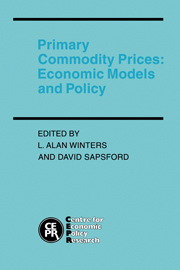Book contents
- Frontmatter
- Contents
- List of figures
- List of tables
- Preface
- List of conference participants
- 1 Primary commodity prices: an introduction to the major policy and modelling challenges
- I ECONOMETRIC ANALYSES
- 2 Estimation of dynamic disequilibrium models with rational expectations: the case of commodity markets
- 3 Modelling expectations formation in primary commodity markets
- 4 The prices of perennial crops: the role of rational expectations and commodity stocks
- II SECTORAL STUDIES: FOODS, MATERIALS AND ENERGY
- III STABILIZATION SCHEMES
- Index
3 - Modelling expectations formation in primary commodity markets
from I - ECONOMETRIC ANALYSES
Published online by Cambridge University Press: 05 March 2012
- Frontmatter
- Contents
- List of figures
- List of tables
- Preface
- List of conference participants
- 1 Primary commodity prices: an introduction to the major policy and modelling challenges
- I ECONOMETRIC ANALYSES
- 2 Estimation of dynamic disequilibrium models with rational expectations: the case of commodity markets
- 3 Modelling expectations formation in primary commodity markets
- 4 The prices of perennial crops: the role of rational expectations and commodity stocks
- II SECTORAL STUDIES: FOODS, MATERIALS AND ENERGY
- III STABILIZATION SCHEMES
- Index
Summary
Introduction
The traditional textbook paradigm requires that primary commodity prices adjust to clear the market. Since production and consumption are generally inelastic over the short run (certainly periods of one year or less) this suggests that fluctuations in demands (boom or recession in the industrialized countries) or supply (good or bad harvests) may result in considerable price variability. Primary commodity prices are indeed highly volatile, and this has been taken by some as providing a prima facie case for price stabilizing intervention.
On the other hand, it is also widely recognized that storage is at least potentially important in these markets, and that the demand for storage might in principle be highly elastic. Private agents will typically buy low and sell high, and this will provide a degree of automatic stabilization via the market. If that is the case, it is not clear that one should expect the public sector to be any more efficient than the private sector in providing the socially optimal level of storage.
Extensive storage by the private sector also has other implications. Agents undertaking storage activities will be conscious of the opportunity cost of the funds that they use for this purpose, and this implies that storage, and therefore also commodity prices, will be sensitive to the rate of interest. Primary commodities will then behave to some extent like financial assets.
- Type
- Chapter
- Information
- Primary Commodity PricesEconomic Models and Policy, pp. 44 - 71Publisher: Cambridge University PressPrint publication year: 1990



